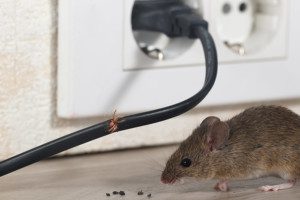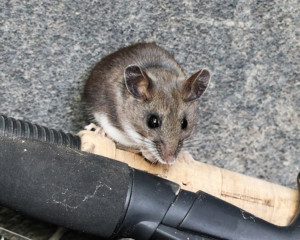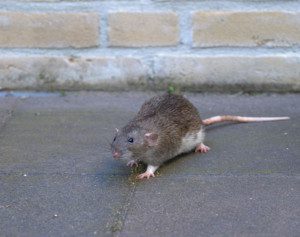Rodent Infestations in residential or commercial settings are typically the result of one of four common mice or rat types. Regardless of the type of rodent, in most cases, once you’ve identified a problem inside or outside your building, its best to get in touch with a pest control expert to eradicate the mice or rat population quickly and effectively. By learning more about these three common rodents you can more easily identify their presence and help control environmental conditions to prevent entry and potential infestation issues.
1. House Mouse
 House mice are small rodents with rounded ears, a short snout and a long tail. Their color varies from light to dark brown. Outside of scurrying or gnawing sounds, a house mouse can be identified by a high pitched squeaking sound. Another common indicator of their presence is regular sightings of mouse droppings about a quarter inch long with pointed ends and dark in color. These common mice tend to thrive in many conditions and building types, including homes, office buildings and open fields. House mice are quick runners as well as great jumpers and swimmers. They reach sexual maturity at one month of age and in optimal conditions will produce 6 – 10 litters per year with 5 – 7 pups per litter! Common foods for a house mouse include meat, seeds and cereal grains.
House mice are small rodents with rounded ears, a short snout and a long tail. Their color varies from light to dark brown. Outside of scurrying or gnawing sounds, a house mouse can be identified by a high pitched squeaking sound. Another common indicator of their presence is regular sightings of mouse droppings about a quarter inch long with pointed ends and dark in color. These common mice tend to thrive in many conditions and building types, including homes, office buildings and open fields. House mice are quick runners as well as great jumpers and swimmers. They reach sexual maturity at one month of age and in optimal conditions will produce 6 – 10 litters per year with 5 – 7 pups per litter! Common foods for a house mouse include meat, seeds and cereal grains.
2. Deer Mouse
 Deer mice live up to two years and are reddish-brown to golden-brown in color. They are about four inches long with a tail length of 2.5 inches. Deer mice are larger than house mice and their tails are covered in fur. They also reproduce less frequently with only 4 pups per litter and only 2 – 4 litters per year. A deer mouse likes to eat insects, nuts and berries. Like the house mouse, their droppings are roughly one quarter inch in length and dark in color with pointed ends. Deer mice, however, are more likely to live in the country than in urban areas, commonly living in places like barns, garages and under trees. Like most rodents, deer mice are nocturnal and usually most active just before sunrise and just after sunset.
Deer mice live up to two years and are reddish-brown to golden-brown in color. They are about four inches long with a tail length of 2.5 inches. Deer mice are larger than house mice and their tails are covered in fur. They also reproduce less frequently with only 4 pups per litter and only 2 – 4 litters per year. A deer mouse likes to eat insects, nuts and berries. Like the house mouse, their droppings are roughly one quarter inch in length and dark in color with pointed ends. Deer mice, however, are more likely to live in the country than in urban areas, commonly living in places like barns, garages and under trees. Like most rodents, deer mice are nocturnal and usually most active just before sunrise and just after sunset.
3. Norway Rat
 Usually grayish-brown in color, Norway rats are also commonly known as gray rats, brown rats or sewer rats – they often live and nest underground. While a Norway rat can reach up to 16 inches in length they are typically 7 – 10 inches long with a 6 – 8 inches long tail. They have small ears and large protruding black eyes. Norway rats have a short lifespan ranging from 5 – 12 months. However, during that short time period each female will typically give birth to 20 offspring! Like most rodents, Norway rats aren’t picky eaters, eating most garbage ranging from cereal to insects, fruit and pet food. Their droppings are longer than those of mice, roughly three quarters of an inch long, dark with blunt ends and usually found in groupings.
Usually grayish-brown in color, Norway rats are also commonly known as gray rats, brown rats or sewer rats – they often live and nest underground. While a Norway rat can reach up to 16 inches in length they are typically 7 – 10 inches long with a 6 – 8 inches long tail. They have small ears and large protruding black eyes. Norway rats have a short lifespan ranging from 5 – 12 months. However, during that short time period each female will typically give birth to 20 offspring! Like most rodents, Norway rats aren’t picky eaters, eating most garbage ranging from cereal to insects, fruit and pet food. Their droppings are longer than those of mice, roughly three quarters of an inch long, dark with blunt ends and usually found in groupings.